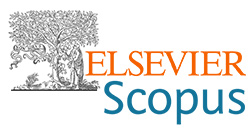Protection of carbon steel against corrosion with a superhydrophobic coating
DOI:
https://doi.org/10.5937/zasmat2303283TAbstract
Under atmospheric conditions at 100% humidity, a surface phase film of moisture is formed on the surface of metals, in which air microimpurities NH3, CO2, H2S, etc. are dissolved and almost completely hydrated with the formation of NH4OH and acids H2CO3 and H2S. The method of potentiodynamic polarization has been used to study the protective efficiency of a superhydrophobic coating on carbon steel in NaCl-based model media simulating saturation of the surface moisture film with carbon dioxide (IV) and/or ammonia under atmospheric conditions. Similar studies were carried out with uncoated electrodes. The superhydrophobic coating was obtained on the basis of laser texturing of the steel surface followed by hydrophobization with fluoroxysilane (wetting angle 165±2°, rolling angle 3±1°). The influence of the duration of exposure of electrodes in solution (0.25 - 168 h) on the kinetics of electrode processes, the rate of steel corrosion and the protective effectiveness of the superhydrophobic coating is considered. It has been shown that the presence of ammonium hydroxide or ammonium carbonate in solution increases the protective effectiveness of the coating compared to a purely chloride medium simulating harsh atmospheric conditions.Keywords:
carbon steel, corrosion, protection, superhydrophobic coating, contact angle, ammonia, carbon dioxide (IV), potentiodynamic polarizationReferences
Boinovich, L., Emelyanenko, A. (2012) A wetting experiment as a tool to study the physicochemical processes accompanying the contact of hydrophobic and super-hydrophobic materials with aqueous media.Adv. Colloid Interface Sci, 179, 133-141
https://doi.org/10.1016/j.cis.2012.06.010
Boinovich, L.B., Emelyanenko, A.M. (2008) Hydrophobic materials and coatings: Principles of creation, properties, application.Uspek hikhimii, 77(7), 619-638
https://doi.org/10.1070/RC2008v077n07ABEH003775
Boinovich, L.B., Emelyanenko, K.A., Emelyanenko, A.M. (2018) Laser tailoring the surface chemistry and morphology for wear, scale and corrosion resistant superhydrophobic coatings.Langmuir, 34(24), 7059-7066
https://doi.org/10.1021/acs.langmuir.8b01317
Boinovich, L.B., Gnedenkov, S.V., Alpysbaeva, D.A., Egorkin, V.S., Emelyanenko, A.M., Sinebryukhov, S.L., Zaretskaya, A.K. (2012) Corrosion resistance of composite coatings on low-carbon steel containing hydrophobic and superhydrophobic layers in combination with oxide sublayers.Corros. Sci, 55, 238-245
https://doi.org/10.1016/j.corsci.2011.10.023
Hooda, A., Goyat, M.S., Pandey, J.K., Kumar, A., Gupta, R.A. (2020) A review on fundamentals, constraints and fabrication techniques of superhydrophobic coatings.Prog.Org.Coat, 142, 105557
https://doi.org/10.1016/j.porgcoat.2020.105557
Hu, C., Xie, X., Zheng, H., Qing, Y., Ren, K. (2020) Facile fabrication of superhydrophobic zinc coatings with corrosion resistance by electrodeposition process.New J. Chem, 44, 8890-8901
https://doi.org/10.1039/D0NJ00561D
Hua, Z., Yang, J., Wang, T., Liu, G., Zhang, G. (2013) Transparent surface with reversibly switchable wettability between superhydrophobicity and superhydrophilicity.Langmuir, 29, 10307-10312
https://doi.org/10.1021/la402584v
Ou, J., Liu, M., Li, W., Xue, M., Li, C. (2012) Corrosion behavior of super-hydrophobic surfaces of Ni alloys in NaCl solutions.Appl. Surf. Sci, 258, 4724-4728
https://doi.org/10.1016/j.apsusc.2012.01.066
Tsygankova, L.E., Vigdorowitsch, M. (2022) Anti-corrosion effectiveness of superhydrophobic coatings on metals: Overview.International Journal of Corrosion and Scale Inhibition, 11(3): 889-940
Downloads
Published
Issue
Section
License
Copyright (c) 2023 CC BY 4.0 by Authors

This work is licensed under a Creative Commons Attribution 4.0 International License.






